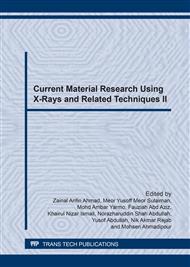[1]
ASTM C27-98: Standard Classification of Fireclay and High-Alumina Refractory Brick, ASTM International. 15 (1) (2013).
Google Scholar
[2]
Information on http: /www. webserver. dmtupm. es/isidoro/ot1.
Google Scholar
[3]
C.O. Okengo, E.O. Nwabineli, Production of insulating bricks using unwana clay, edda clay, kaolin and wood soft dust, International Journal of Engineering and Science. 3 (2012) 184-187.
Google Scholar
[4]
R.O. Zahide, A. Nuran, Investigation of porosity of ceramic tiles by means of image analysis method, Journal of Ceramic Processing Research, 6 (2014) 393-397.
Google Scholar
[5]
C. Sadik, I. El-Amrani and A. Albizane, Recent advances in silica-alumina refractory: A review, Journal of Asia Ceramic Societies, 2 (2014) 83-96.
DOI: 10.1016/j.jascer.2014.03.001
Google Scholar
[6]
M. Raimondo, C. Zanelli, F. Matteucci, G. Guarini, M. Dondi, J. A. Labrincha, Effect of waste glass (TV/PC cathodic tube and screen) on technological properties and sintering behavior of porcelain stoneware tiles, Ceram. Int., 4 (2007) 615-623.
DOI: 10.1016/j.ceramint.2005.11.012
Google Scholar
[7]
H.M. Kefas, D.O. Patrick, T.M. Chiroma, Characterization of Mayo-Belwa Clay, Leonardo Electronic, Journal of Practices and Technologies, 11 (2007) 123-130.
Google Scholar
[8]
O.J. Omowumi, Characterisation of some Nigerian clays as refractory materials for furnace lining, Journal of Engineering and Management, 3 (2001) 1-4.
Google Scholar
[9]
A. Onyeji, Analysis and characterization of Nyikangbe day, chanchaga L.G. A, Niger State, Journal of Metallurgy and Material Engineering, 5 (2010) 55-62.
Google Scholar
[10]
U. Musa, M.A. Aliyu, I.M. Mohammed, M.M. Sadiq, A comparative study on the refractory properties of selected clays in north central Nigeria, Academic Research International, 1 (2012) 393-398.
Google Scholar
[11]
A. Oyetunji, I. Opaluwa, Study the compressive strength of produced sand cores using clay and starch as binder for the casting of aluminium alloy T-Joint pipe, The International Research Journal of Engineering and Technologies, 3 (2012) 50-60.
Google Scholar
[12]
ASTM D4220/D4220M-14: Standard practices for preserving and transporting soil samples, ASTM International, Vol. 15 (1) (2014).
Google Scholar
[13]
ASTM C179-14: Standard test method for drying and firing linear change of refractory plastic and ramming mix specimens, ASTM International, 15 (1) (2014).
DOI: 10.1520/c0179
Google Scholar
[14]
ASTM C20-00: Standard test method for apparent porosity, water absorption, apparent porosity, specific gravity and bulk density, ASTM International, 15 (1) (2015).
DOI: 10.1520/c0373
Google Scholar
[15]
ASTM C493-98: Standard test method for bulk density and porosity of granular refractory materials by mercury displacement, ASTM International, 15 (1) (2002).
DOI: 10.1520/c0493
Google Scholar
[16]
ASTM C133-97: Standard test method for cold crushing strength and modulus of rupture of refractories, ASTM International, 15 (1) (2015).
Google Scholar
[17]
ASTM C24-09: Standard test method for pyrometric cone equivalent (pce) of fireclay and high alumina refractory materials, ASTM International, Vol. 15 (1) (2013).
DOI: 10.1520/c0024-09r18
Google Scholar
[18]
ASTM C1100-88: Standard test method for ribbon thermal shock testing of refractory materials, ASTM International, 15 (1) (1998).
Google Scholar
[19]
J.H. Chester: Refractories, production and properties, handbook published the iron and steel institute, london (1973).
Google Scholar
[20]
S. Aliyu, B. Garba, B.G. Danshehu, G.M. Argungu, A.D. Isah, Physio-chemical Analysis of gwarmi clay deposit, wurno local government area of sokoto state, nigeria, International Journal of Engineering and Science, 16 (2014) 62-67.
Google Scholar


